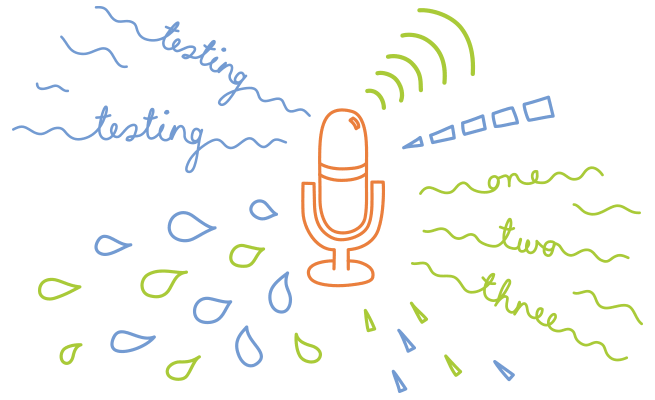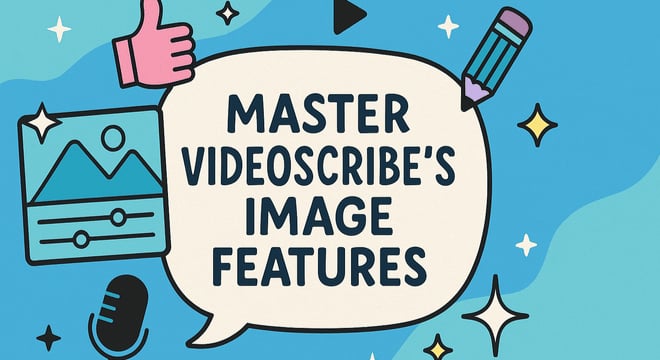
The most effective scribes use a combination of voiceover and visuals for maximum impact. If you're thinking of recording your own voiceover, here's the advice from Sparkol's own sound experts.
A lot of professional scribers insist that using a voiceover artist is one of the best ways to enhance your message. This is largely true for two reasons:
- Even though we do most of our learning visually, we have a lower tolerance for poor audio quality than we do poor video quality
- A professional-sounding voice audio will add credibility to your video and content
However, if the time or budget does not allow for a professional voice artist, don't worry. It's possible to record a good voiceover without a professional actor or expensive equipment.
The most important thing is that the voiceover and images come together properly with skillful editing. Proper timing ensures that the viewers' eyes and ears receive the same information simultaneously. If the audio doesn't match up with the visuals, the viewer will favor the visual. The script – the backbone of the scribe – will be ignored.
Before you get started you should check out our perfect voice over checklist.
Planning your voiceover
Click the microphone symbol in VideoScribe to record a voiceover directly or to import a voiceover from your computer or a URL.
If you are recording your voiceover separately, Audacity is a good, free audio-editing program.
There are two ways to approach making a scribe with a voiceover. Either:
Make the scribe first
Time roughly how long it takes you to read through your script and make a scribe that matches the length. Then record your script directly into VideoScribe or record separately and import the voiceover as an MP3.
If recording outside of VideoScribe, you may find it helpful to watch your scribe play back as you speak, so that you can match the pace. Once you are done, adjust the elements to fit better to your voiceover.
Record the voiceover first
Be careful not to read your script too quickly as you need to leave enough time for your images in your scribe to be drawn and understood. This method is slightly trickier as you will need to time your finished voiceover and make a scribe that fits to it exactly.
Record or import your voiceover into VideoScribe and begin matching the elements to what is being said. You may need to adjust draw times considerably to match the pace of your voice.
Preparing your script
- Make your script as tight as possible. Avoid clichés and remove anything that isn't completely necessary to get your point across.
- Read your script again and again to familiarise yourself with the words and get it down to the right length.
- Practise in front of family members and friends. If anything sounds odd or complicated to them, change it.
- Think about the emotion you want to communicate and adjust your tone and emphasis accordingly.
- Practise again.
Making the recording
- Find yourself a suitable microphone. If you're using the computer's built-in microphone, speak at a normal level to prevent it from clipping the sound.
- Find a quiet and echoless room where you won't be interrupted. A natural-sounding and noise-free recording is your goal.
- Test your microphone out by recording a few lines first. This will save you time by reducing wasted takes, giving you the chance to change the levels and adjust the distance you're sitting from the microphone if it doesn't sound good
- Just like a TV presenter, talking with a smile on your face will help you to sound natural and enthusiastic about your topic
- An editing program like Audacity will allow you to remove unwanted pauses and mistakes.
Optimizing the audio track
- Play your scribe through a few times. Go back and adjust the volume of your recording if you need to. Too loud and the audio will be an unpleasant and distracting shock for your viewer. Too quiet, and your scribe will not have the same impact, being quickly dismissed.
- Test the sound through a variety of speakers. Play the scribe to your long-suffering friends and family again!
- If you decide to use a backing track, be sensitive to the mood of your scribe and pick a track that complements the type of voiceover you're using. Your backing track should always sit just lower in volume than your voiceover audio so it doesn't distract from your message.
If you've never tried recording your own voiceover, give it a go. Voiceover is one of the elements that makes scribe videos so powerful. When it comes together with the visuals – magic happens!
Check out our ultimate guide to voice overs.


.png)



![How to create animation magic [3-part guide to video success]](https://blog.videoscribe.co/hubfs/How%20to%20create%20animation%20magic%20guide%20VideoScribe.png)


.png)


COMMENTS